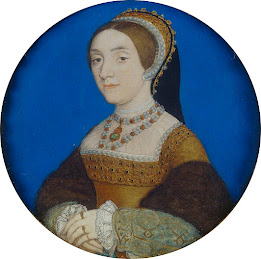A Tudor Christmas - Christmas Day
25th December - The Great Dat Of Feasting
A Christmas dinner was served in honour of Nativity and after the various religious observations had been followed. Plum porridge was a firm favourite, it was said to line the stomach for the rich food that was to follow. This is were the idea of Chistmas Pudding came from as the Victorians changed the recipe. The festive favourite that was eaten by all classes was brawn, this was made from the fatty cuts of boar or pork soaked in red wine (in modern times it is calf's or pig's head pressed in a tub with jelly, much less appealing). It was said that beef was the choice of meat everyone wanted for Christmas.
 For the rich and nobility, the first course was most commonly a boars head. Henry would eat his alone in his chambers. It would still contain it bones, was stuffed, covered in mustard, dressed in herbs, fruit and with an apple in its mouth. It would then sometimes be painted in bright colours and the tusks covered in gold leaf. Because boar slowly became extinct, it was only reserved for the nobles and would be a status symbol. Once done it would be brought to the table in great ceremony and a carol was sung:
For the rich and nobility, the first course was most commonly a boars head. Henry would eat his alone in his chambers. It would still contain it bones, was stuffed, covered in mustard, dressed in herbs, fruit and with an apple in its mouth. It would then sometimes be painted in bright colours and the tusks covered in gold leaf. Because boar slowly became extinct, it was only reserved for the nobles and would be a status symbol. Once done it would be brought to the table in great ceremony and a carol was sung:
“The boars head in hand bear I,
Bedeck’d with bays and rosemary,
And I pray you, my masters, be merry
Quo testis in convivio.
Caput apri defero
Reddens laudes Domino
(Lo, behold the head I bring
Giving praise to God we sing)
The boar’s head, as I understand,
Is the rarest dish in all this land,
Which thus bedeck’d with a gay garland
Let us servire cantico
Caput apri defero
Reddens laudes Domino
Our steward hath provided this
In honour of the King of Bliss;
Which on this day to be served is
In Reginensi atrio.
Caput apri defero
Reddens laudes Domino”

Christmas pudding was also popular, at the time it was a suet pudding. Mince pies were also well known, made with leftover shreeded meats. Compared to the ones we have today, they were much bigger and would be cut with a spoon, the first piece given to the youngest person who would then make a wish. Once dinner was done, everyone would then go on to enjoy and celebrate the other festive pleasure that were on offer.






Comments
Post a Comment